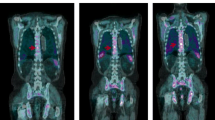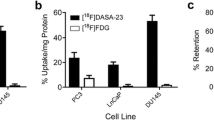Abstract
Purpose
The objective of the present study is to determine whether uptake of [18F]fluoromethylcholine ([18F]FCH) in comparison with 2-deoxy-2-[18F]fluoro-D-glucose ([18F]FDG) accurately reflects chemotherapy efficacy at the tumor cell level in prostate cancer (PC).
Procedures
The effects of docetaxel and cabazitaxel on viable tumor cell number were explored in four PC cell lines. Cellular uptake of [18F]FDG and [18F]FCH was compared with the effects measured using sulforhodamine B (SRB) assay, cell counting and colony formation assay (CFA), as proximators of viable tumor cell number. Agreement between uptake and cell numbers was assessed by Bland-Altman plots.
Results
[18F]FCH uptake in all PC cell lines significantly correlated to the cell numbers surviving the respective drug concentrations. Bland-Altman analysis showed that [18F]FDG uptake resulted in signal overestimation and higher variability after chemotherapy.
Conclusions
[18F]FCH uptake correlates well with viable tumor cell numbers remaining after docetaxel and cabazitaxel exposure. Radiolabeled choline is a potential response monitoring biomarker after chemotherapy for PC.




Similar content being viewed by others
References
Jemal A, Bray F, Center MM et al (2011) Global cancer statistics. CA Cancer J Clin 61:69–90
Fizazi K, Scher HI, Molina A et al (2012) Abiraterone acetate for treatment of metastatic castration-resistant prostate cancer: final overall survival analysis of the COU-AA-301 randomised, double-blind, placebo-controlled phase 3 study. Lancet Oncol 13:983–992
Ryan CJ, Smith MR, de Bono JS et al (2013) Abiraterone in metastatic prostate cancer without previous chemotherapy. N Engl J Med 368:138–148
Scher HI, Fizazi K, Saad F et al (2012) Increased survival with enzalutamide in prostate cancer after chemotherapy. N Engl J Med 367:1187–1197
Kantoff PW, Higano CS, Shore ND et al (2010) Sipuleucel-T immunotherapy for castration-resistant prostate cancer. N Engl J Med 363:411–422
Berthold DR, Pond GR, Soban F et al (2008) Docetaxel plus prednisone or mitoxantrone plus prednisone for advanced prostate cancer: updated survival in the TAX 327 study. J Clin Oncol 26:242–245
De Bono JS, Oudard S, Ozguroglu M et al (2010) Prednisone plus cabazitaxel or mitoxantrone for metastatic castration-resistant prostate cancer progressing after docetaxel treatment: a randomised open-label trial. Lancet 376:1147–1154
Parker C, Nilsson S, Heinrich D et al (2013) Alpha emitter radium-223 and survival in metastatic prostate cancer. N Engl J Med 369:213–223
Basch EM, Somerfield MR, Beer TM et al (2007) American Society of Clinical Oncology endorsement of the Cancer Care Ontario Practice Guideline on nonhormonal therapy for men with metastatic hormone-refractory (castration-resistant) prostate cancer. J Clin Oncol 25:5313–5318
Heidenreich A, Bastian PJ, Bellmunt J et al (2014) EAU guidelines on prostate cancer. Part II: treatment of advanced, relapsing, and castration-resistant prostate cancer. Eur Urol 65:467–479
Scher HI, Morris MJ, Basch E, Heller G (2011) End points and outcomes in castration-resistant prostate cancer: from clinical trials to clinical practice. J Clin Oncol 29:3695–3704
Lilja H, Ulmert D, Vickers AJ (2008) Prostate-specific antigen and prostate cancer: prediction, detection and monitoring. Nat Rev Cancer 8:268–278
Wahl RL, Jacene H, Kasamon Y, Lodge MA (2009) From RECIST to PERCIST: evolving considerations for PET response criteria in solid tumors. J Nucl Med 50(Suppl 1):122S–150S
Costelloe CM, Chuang HH, Madewell JE, Ueno NT (2010) Cancer response criteria and bone metastases: RECIST 1.1, MDA and PERCIST. J Cancer 1:80–92
Wallace TJ, Torre T, Grob M et al (2014) Current approaches, challenges and future directions for monitoring treatment response in prostate cancer. J Cancer 5:3–24
Price DT, Coleman RE, Liao RP et al (2002) Comparison of [18F]fluorocholine and [18F]fluorodeoxyglucose for positron emission tomography of androgen dependent and androgen independent prostate cancer. J Urol 168:273–280
Morris MJ, Akhurst T, Larson SM et al (2005) Fluorodeoxyglucose positron emission tomography as an outcome measure for castrate metastatic prostate cancer treated with antimicrotubule chemotherapy. Clin Cancer Res 11:3210–3216
Oyama N, Hasegawa Y, Kiyono Y et al (2011) Early response assessment in prostate carcinoma by 18F-fluorothymidine following anticancer therapy with docetaxel using preclinical tumour models. Eur J Nucl Med Mol Imaging 38:81–89
Yu EY, Muzi M, Hackenbracht JA et al (2011) C11-acetate and F-18 FDG PET for men with prostate cancer bone metastases: relative findings and response to therapy. Clin Nucl Med 36:192–198
Witney TH, Fortt RR, Aboagye EO (2014) Preclinical assessment of carboplatin treatment efficacy in lung cancer by 18F-ICMT-11-positron emission tomography. PLoS One 9:e91694
Afshar-Oromieh A, Zechmann CM, Malcher A et al (2014) Comparison of PET imaging with a (68)Ga-labelled PSMA ligand and (18)F-choline-based PET/CT for the diagnosis of recurrent prostate cancer. Eur J Nucl Med Mol Imaging 41:11–20
DeGrado TR, Baldwin SW, Wang S et al (2001) Synthesis and evaluation of (18)F-labeled choline analogs as oncologic PET tracers. J Nucl Med 42:1805–1814
Evangelista L, Zattoni F, Guttilla A et al (2013) Choline PET or PET/CT and biochemical relapse of prostate cancer: a systematic review and meta-analysis. Clin Nucl Med 38:305–314
Cimitan M, Bortolus R, Morassut S et al (2006) [18F]fluorocholine PET/CT imaging for the detection of recurrent prostate cancer at PSA relapse: experience in 100 consecutive patients. Eur J Nucl Med Mol Imaging 33:1387–1398
Umbehr MH, Müntener M, Hany T et al (2013) The role of 11C-choline and 18F-fluorocholine positron emission tomography (PET) and PET/CT in prostate cancer: a systematic review and meta-analysis. Eur Urol 64:106–117
Beheshti M, Vali R, Waldenberger P et al (2009) The use of F-18 choline PET in the assessment of bone metastases in prostate cancer: correlation with morphological changes on CT. Mol Imaging Biol 11:446–454
Beheshti M, Vali R, Waldenberger P et al (2008) Detection of bone metastases in patients with prostate cancer by 18F fluorocholine and 18F fluoride PET-CT: a comparative study. Eur J Nucl Med Mol Imaging 35:1766–1774
Müller SA, Holzapfel K, Seidl C et al (2009) Characterization of choline uptake in prostate cancer cells following bicalutamide and docetaxel treatment. Eur J Nucl Med Mol Imaging 36:1434–1442
Geldof AA, Rao BR, de Voogt HJ (1986) Direct effects of chemotherapeutic agents on rat prostate tumor clonogenic cells. Anticancer Res 6:837–840
Oprea-Lager DE, Bijnsdorp IV, Van Moorselaar RJA et al (2013) ABCC4 Decreases docetaxel and not cabazitaxel efficacy in prostate cancer cells in vitro. Anticancer Res 33:387–391
Bijnsdorp IV, Kruyt FA, Gokoel S et al (2008) Synergistic interaction between trifluorothymidine and docetaxel is sequence dependent. Cancer Sci 99:2302–2308
Mastbergen SC, Duivenvoorden I, Versteegh RT, Geldof AA (2000) Cell cycle arrest and clonogenic tumor cell kill by divergent chemotherapeutic drugs. Anticancer Res 20:1833–1838
Altman DG, Bland JM (1983) Measurement in medicine: the analysis of method comparison studies. Statisics 32:307–317
Bland JM, Altman DG (1986) Statistical methods for assessing agreement between two methods of clinical measurement. Lancet 1:307–310
Schwarzenböck S, Souvatzoglou M, Krause BJ (2012) Choline PET and PET/CT in primary diagnosis and staging of prostate cancer. Theranostics 2:318–330
Vrignaud P, Sémiond D, Lejeune P et al (2013) Preclinical antitumor activity of cabazitaxel, a semisynthetic taxane active in taxane-resistant tumors. Clin Cancer Res 19:2973–2983
Schwarzenböck S, Sachs D, Souvatzoglou M et al (2013) [11C]choline as a pharmacodynamic marker for docetaxel therapy. Response assessment in a LNCaP prostate cancer xenograft mouse model. Nuklearmedizin 52:141–147
Krause BJ, Souvatzoglou M, Herrmann K et al (2010) [11C]Choline as pharmacodynamic marker for therapy response assessment in a prostate cancer xenograft model. Eur J Nucl Med Mol Imaging 37:1861–1868
Jensen LR, Huuse EM, Bathen TF et al (2010) Assessment of early docetaxel response in an experimental model of human breast cancer using DCE-MRI, ex vivo HR MAS, and in vivo 1H MRS. NMR Biomed 23:56–65
Awwad HM, Geisel J, Obeid R (2012) The role of choline in prostate cancer. Clin Biochem 45:1548–1553
Taguchi C, Inazu M, Saiki I et al (2014) Functional analysis of [methyl-(3)H]choline uptake in glioblastoma cells: influence of anti-cancer and central nervous system drugs. Biochem Pharmacol 88:303–312
Engles JM, Quarless SA, Mambo E et al (2006) Stunning and its effect on 3H-FDG uptake and key gene expression in breast cancer cells undergoing chemotherapy. J Nucl Med 47:603–608
Bjurberg M, Henriksson E, Brun E et al (2009) Early changes in 2-deoxy-2-[18F]fluoro-D-glucose metabolism in squamous-cell carcinoma during chemotherapy in vivo and in vitro. Cancer Biother Radiopharm 24:327–332
Conflict of Interest
The authors declare that they have no conflict of interest.
Author information
Authors and Affiliations
Corresponding author
Rights and permissions
About this article
Cite this article
Oprea-Lager, D.E., van Kanten, M.P., van Moorselaar, R.J.A. et al. [18F]Fluoromethylcholine as a Chemotherapy Response Read-Out in Prostate Cancer Cells. Mol Imaging Biol 17, 319–327 (2015). https://doi.org/10.1007/s11307-014-0803-7
Published:
Issue Date:
DOI: https://doi.org/10.1007/s11307-014-0803-7




